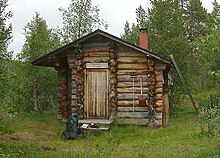Lemmenjoki National Park
The Lemmenjoki National Park is a national park in the north of Finland . It is located in the province of Lapland on the border with Norway, mostly in the area of the municipality of Inari , and a smaller part in Kittilä . The Lemmenjoki River gives the national park its name . The national park, administered by the Finnish forest authority Metsähallitus , was established in 1956 and expanded twice. Today it is the largest national park in Finland with an area of 2850 km² (more than the area of Luxembourg ). The Øvre Anárjohka National Park continues on the Norwegian side .
nature
The Lemmenjoki National Park is one of the largest deserted wilderness areas in Europe (excluding Russia). The landscape of the national park is the Lemmenjoki River, to the fells dominated flows past Maarestatunturi and Viipustunturi, and numerous smaller rivers. Pine trees grow in the Lemmenjoki river valley and mainly birch trees elsewhere . Tundra- like vegetation prevails at higher altitudes . The spruce reaches the northern limit of its range in the southern part of the national park. There are also extensive moorland areas in Lemmenjoki National Park . Larger populations of brown bears , golden eagles and elks , and occasionally wolves, live in the national park . In addition, around 7500 semi-domesticated reindeer can be found in Lemmenjoki National Park , whose breeding is the traditional livelihood of the Sami .
Visitors
The national park is divided into a "base area" and a "wilderness area". In the base area there is a 60 km network of hiking trails with specially designated campfire sites. There are no designated hiking trails in the wilderness area. In smaller protected areas you are only allowed to move on marked paths to a limited extent. There are shelters available to visitors in the National Park . There is a nature center and a 4.5 km nature trail in the village of Njurkalahti.
history
Until the 19th century, forest seeds lived in the Lemmenjoki valley and hunted wild forest reindeer using trap pits . After the forest reindeer became extinct in the 19th century, reindeer herding culture spread to the area. At the same time, settled settlements emerged for the first time in villages like Njurkulahti, which today still mainly live from reindeer herding.
Gold was panned at Lemmenjoki as early as the early 19th century . After the Second World War, a real gold rush began in the 1940s with over 100 claims. Gold is panned in the national park to this day, now also using machine methods.
Web links
- Finnish Forest Service: Lemmenjoki National Park (Engl.)
- World Database on Protected Areas - Lemmenjoki National Park (English)
Coordinates: 68 ° 34 ′ 40 ″ N , 25 ° 36 ′ 1 ″ E

